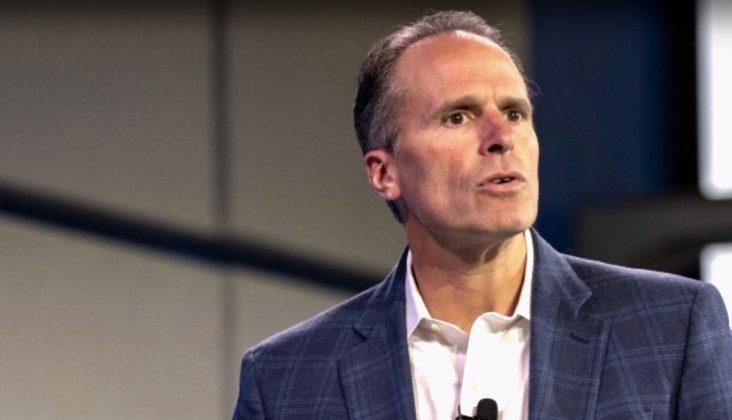Walmart works to move last on tariff price hikes; reviews each product for options
by September 4, 2019 5:55 pm 1,695 views

Steve Bratspies
Through the first three lists of products to be impacted by tariffs in the escalating trade war between the U.S. and China, Steve Bratspies, chief merchandising officer at Walmart, said the impact has been manageable with little impact to customers.
Bratspies, speaking at Barclays Global Consumer Staples Conference in Boston on Wednesday (Sept. 4), said the fourth list goes deeper and it will be tougher to keep prices stable. Bratspies told investors the retail giant is in the process of going through the list line by line, looking for possible ways to mitigate the impact. Walmart is the largest retail importer of goods into the U.S.
“I was really proud of how the team handled lists 1 through 3. And there were a few prices that we did have to change (increase) but we didn’t see any change in our unit projection of where we thought it would be. So, that was absorbed. But we were very focused and targeted on how we did it. We didn’t let any of our price gaps slip. And we maintained price leadership in all of the things that we did, so we ran our model inside that well,” Bratspies said Wednesday.
He told investors “list 4 gets tougher because it covers a lot more products.” Bratspies said Walmart will take the same approach to list 4 by reviewing products item-by-item.
“Our buyers look at what’s the impact on that item, how does that item mix out inside of its category and inside of the larger business? Is it a growth segment? Is it not a growth segment? Is it a direct import versus domestic import or how much inventory do we have already in-country that we can leverage? What mix do we expect,” Bratspies explained.
He said there are lots of different levers a buyer can pull to understand how to manage the impact.
“Our goal is to offset as much as we possibly can, either through negotiation or managing the mix. We have the advantage of an entire box to manage. I’ve got grocery and I can manage things across. So, that’s going to be our objective,” he added.
“At the last resort, if we have to raise prices, we’ll do that to manage our margin to be where we need to be. But we’re going to run the Walmart model, which is to lead on price. We want to keep prices lower and keep downward pressure on prices and not let them creep up. And that’s what we’re going to apply to the tariff situation,” he said.
TARGET RESPONSE
Bratspies said Walmart’s normal pricing strategy is to move prices less and later relative to competitors as much as possible to maintain price gaps. Target said last week it will lean on its suppliers to bear the cost of the trade war with China. Target notified suppliers of its plans to hold prices steady, according to a report by Business Insider. Target did confirm the letter was sent to an undisclosed number of suppliers.
“Target will not accept any new cost increases related to tariffs on goods imported from China,” noted Mark Tritton, chief merchandising officer for Target. “Our expectation is that you will develop the appropriate contingency plans so that we don’t have to pass price increases along to our guests.”
The National Retail Federation has said retailers are using every strategy they can to push those costs back on their suppliers wherever possible. David French, NRF senior vice president of government relations, said too often suppliers being impacted may not be in China. He said they may be U.S. businesses manufacturing goods for retailers from raw materials imported from China.
CUSTOMER FOCUS
Bratspies told investors Walmart is a mass discounter and that will not change. He said the Walmart model is volume driven and customer traffic is what keeps the pump primed. Walmart has reported positive traffic numbers in recent quarters and Bratspies said all the work the retailer has done to provide low prices, better quality items and shopping conveniences are resonating with customers across all generations.
Bratspies also told investors management is continuously working to improve the shopping experience.
“We have a meeting of all the U.S. officers every Monday afternoon. And the first topic is the customer, all the time, and it’s data on NPS scores on our Clean, Fast and Friendly scores, which is a core metric coming out of our stores. And we look at them in total at a macro level and we look at them on a micro-level. We take individual instances and understand why did this customer have a good experience or why did this customer have a bad experience, and we learn from it. And often, that drives specific action out to our stores immediately, if we need to focus on this, we need to change this. Sometimes, it’s a short-term fix. Sometimes, it’s a longer-term fix. But we get really granular with the customer,” Bratspies said.
He said Walmart has data to understand who customers are, what they are buying and what they are doing inside and outside of stores. He said Walmart still has a long way to go in interpreting its data to drive meaningful insights to its fullest potential. That said, he added, “the more business we’re doing, the happier our customers are. We don’t take it for granted, it’s something we work on every day.”
